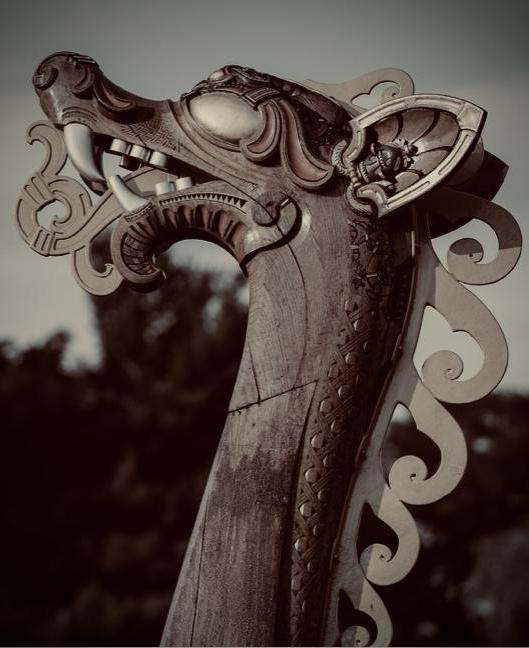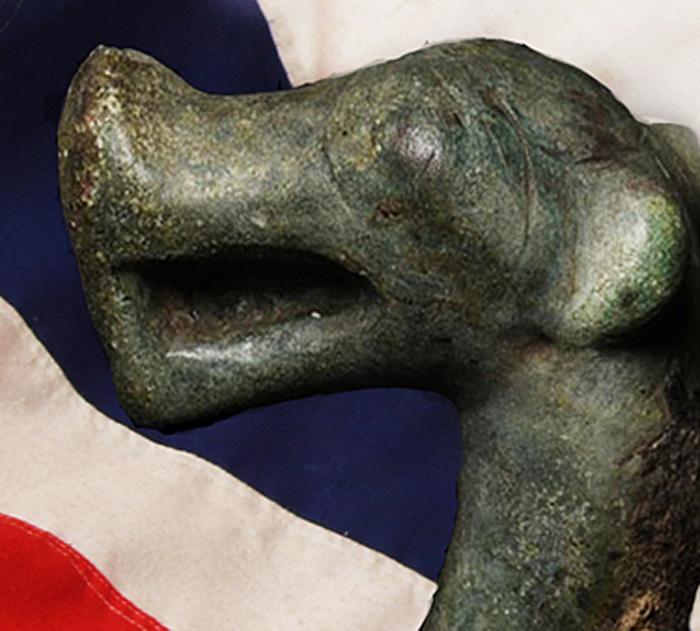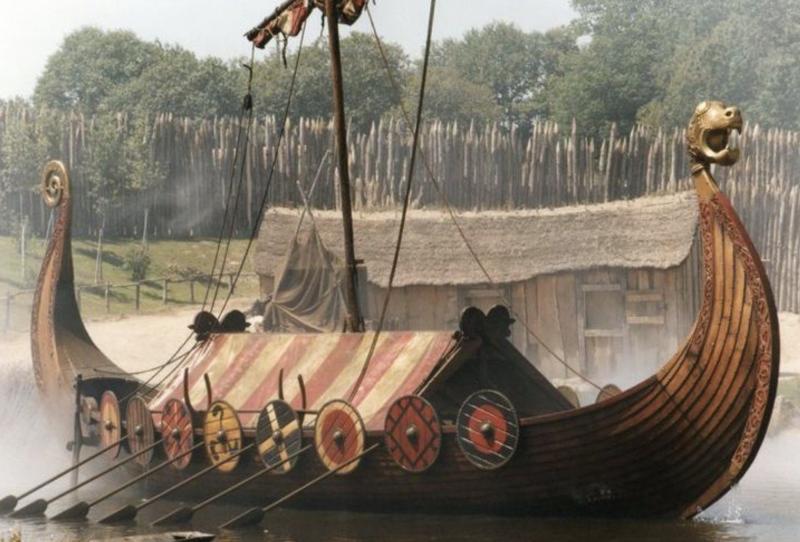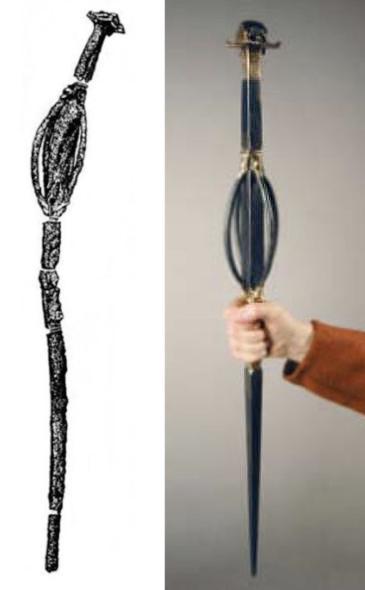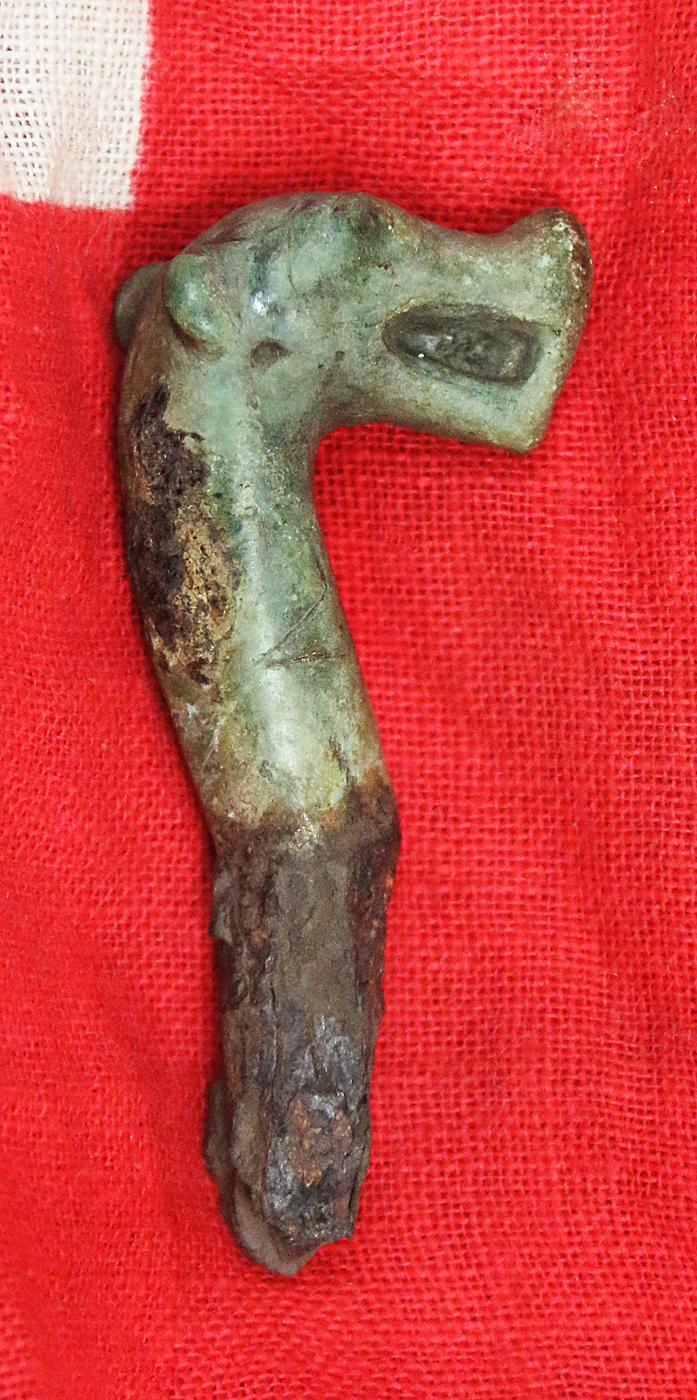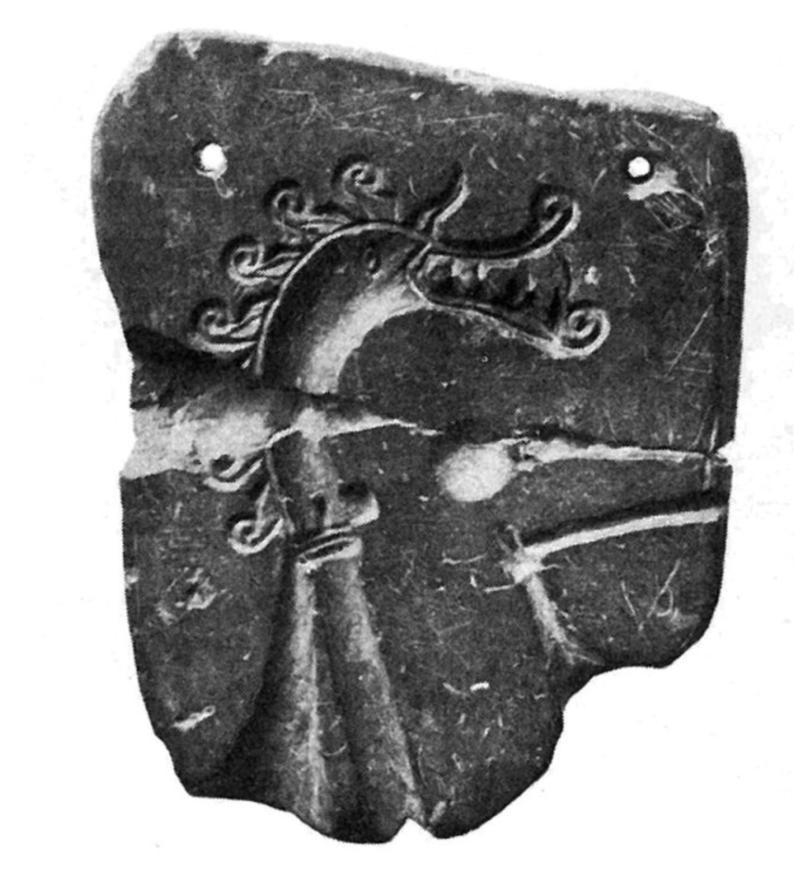An Extraordinary, 1100 to 1200 year old, Original, Ancient Viking Draken Head Staff Mount. A Knob of a Staff or Wand of Magic, Used By A Völva, a Sorcerer or Sorceress of Seiđr. A Seiðstafr, The Staff of Power in Viking Occult & Magick
Just returned from expert conservation {undertaken over many months}.
A fabulous ancient bronze Draken head {Viking for dragon} with remains of its forged iron wand attached to its socket mount. Modelled on one of the greatest iconic symbols of the Viking Norsemen, the Draken head, the iconic symbol on the prow of a Viking longship, the Draken figurehead.
The iron staff or wand was an important accessory used by the Völva when carrying out Seiđr, Viking magic. The.magic staffs were around two to three foot long, forged of iron, often in the form of a distaff, with a knob pommel, that could take many forms, made of other metals, more usually brass or bronze, sometimes the knob might be inlaid with gems, and the staff was used by professional Viking sorcerers and sorceresses when performing Seiđr, the Viking tradition of the occult.
These staffs acquired a plenitude of meanings and functions, from symbolic to practical. As such the staff may be understood as the attribute of a völva, the rod keeping up the world, a distaff spinning the future
"From the beginning seiðr was the prerogative of the gods, and it is clear that its origins predate the Viking Age by several centuries (Hedeager 1997). The sources relate how Òðin became the supreme master of sorcery, having learnt of its powers from the goddess Freyja."
(Price, N. 2008 “Sorcery and Circumpolar Traditions in Old Norse Belief” p. 245 in “The Viking World” Brink, S. & Price, N. eds)
Ok hon hafði staf í hendi, ok var á knappr
Eiríks saga rauða describes a seiðkonur with her staff:
"(Thorbjorg the seiðkonur) was dressed in such wise that she had a blue mantle over her, with strings for the neck, and it was inlaid with gems quite down to the skirt. On her neck she had glass beads. On her head she had a black hood of lambskin, lined with ermine. A staff she had in her hand, with a knob thereon; it was ornamented with brass, and inlaid with gems round about the knob."
A völva buried in Fyrkat, Denmark was buried with a box containing talismans or taufr. These included an owl pellet, small bones from birds and animals as well as henbane seeds. When thrown on a fire, henbane seeds can produce a hallucinogenic smoke that gives those who inhale it a sense of flying which may have enhanced the völva’s trance. The völur who were buried in the Oseberg ship were similarly outfitted with a pouch of cannabis seeds for their journey beyond life.
Völur were also buried with a staff, not only a shamanic implement but also an insignia of their profession. The Old Norse term völva has been widely translated to mean a “wand carrier” or “magical staff bearer”. Many shamans use a ceremonial staff as an object of spiritual power. Held during the visionary ritual of seiðr these seiðstafr or völ, may have been representation of the World Tree as is common among shamans from the Arctic to Asia and down to the Peruvian Amazon. Since the spiritual principle uniting the spirit worlds for the Norse was the Great Tree, Yggdrassil it makes sense that völur would carry a staff. Being able to travel into the realms of the spirits is a critical requirement for any shamanic practitioner. The wand or staff would function as a connection to all the realms of spirit as well as another kind of tether to help a völva return to this world.
We show in the gallery one drawing of a museum exhibit, an iron staff of power recovered from a burial, in Klinta, Oland, Sweden, and held to the right is a recreated copy of the ancient Viking relic with its brass, formed, knob pommel.
Being a staff pommel, we believe it is the smallest surviving part of a Seiðstafr, {The Staff of Power} yet, of all the surviving examples we have seen in the past 50 years, and they are so few as to be near non-existent, this example is, in our opinion, the most iconic Viking image example existing, and likely now unique in the world {so far discovered}, and as such, may be the only surviving part of its type to appear on the open market, or ever likely to.
The closest example we have ever seen are the small, semi flat, cast draken head clothing pins that were cast, often in lead, in intaglio carved mould stones. Which show just how important the draken (dragon) head was to Viking symbolic culture. We show a really rare find, of one such small Draken head clothes pin moulds, in carved soapstone, now in the collection of Swedish History Museum.
For example; With regards to expert conservation methods of bronze {copper alloy} objects {and some other materials} The dirt from the surface of the object could be removed manually using a scalpel under magnification. Care would be taken not to dislodge the powdery, corroding surface. Where the surface was in particualrly bad condition the dirt will be left in situ and small areas might be locally consolidated using 2.5% HMG Paraloid B72 (methyl ethyl methacrlylate) in 50:50 Acetone (propan-1-one/dimethyl ketone) and Industrial methylated spirits (ethanol,methanol. This method of conservation is also used by the British Museum {amongst other institutions}
Our Draken head is approx. 6cm long overall, including the remaining iron staff top.
As with all our items it comes complete with our certificate of authenticity
Code: 24789
3950.00 GBP


